Case Study: Evaluating Sustainability and Business Strategies
VerifiedAdded on 2021/04/20
|7
|1721
|132
Case Study
AI Summary
This case study examines the challenges and opportunities faced by Pure, a vegan food company, within the context of sustainability and business practices. The analysis identifies both superficial and fundamental issues, including customer perceptions, competition, and financial constraints. The study evaluates Pure's goals, competitive market, and current strategies, focusing on its approach to sustainability. It explores various strategic alternatives such as market development and diversification, evaluating their effectiveness using key performance indicators. The recommended strategy emphasizes market development, suggesting a phased implementation to expand market share and brand value. The document references relevant literature and provides a comprehensive overview of the company's position within the vegan food industry.
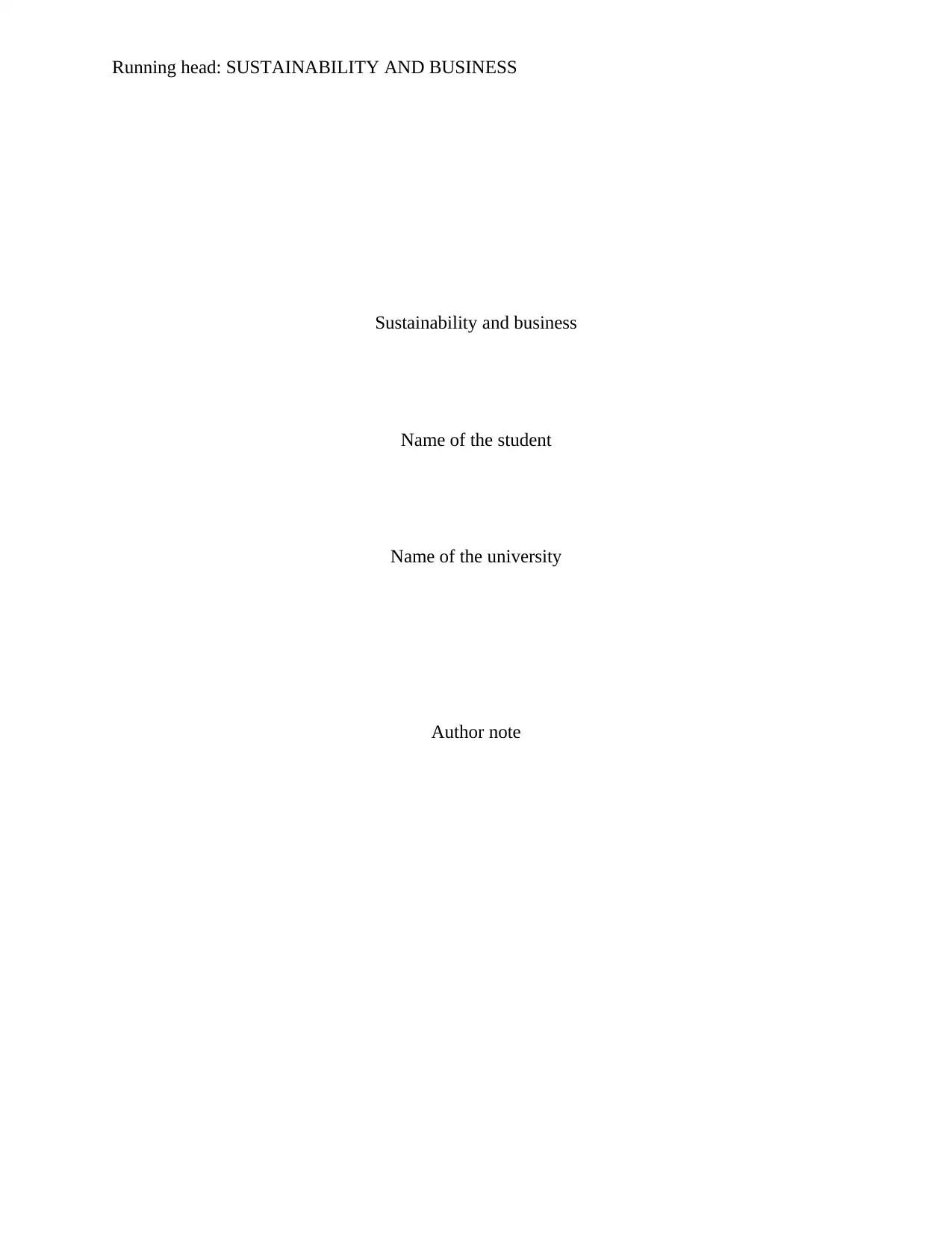
Running head: SUSTAINABILITY AND BUSINESS
Sustainability and business
Name of the student
Name of the university
Author note
Sustainability and business
Name of the student
Name of the university
Author note
Paraphrase This Document
Need a fresh take? Get an instant paraphrase of this document with our AI Paraphraser
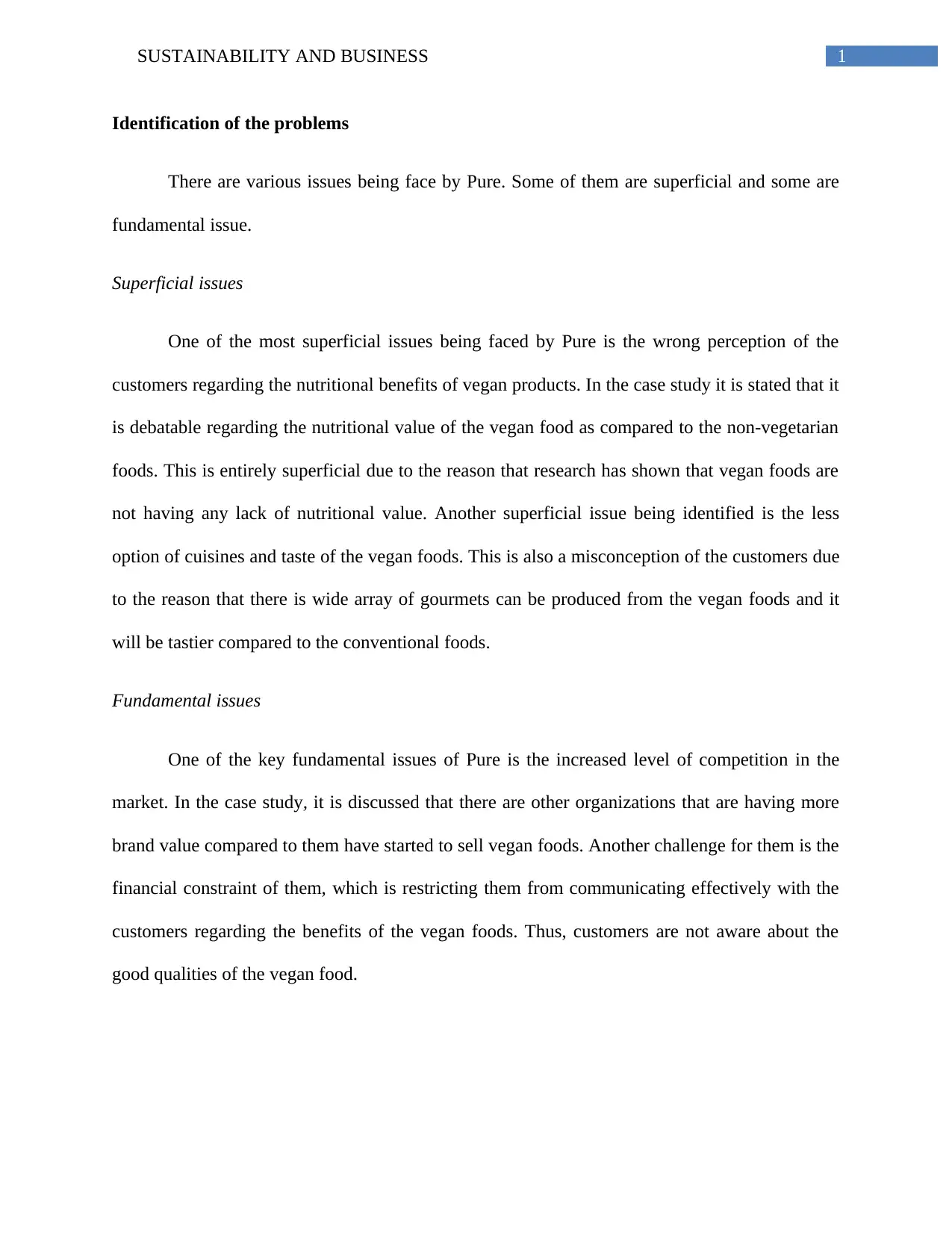
1SUSTAINABILITY AND BUSINESS
Identification of the problems
There are various issues being face by Pure. Some of them are superficial and some are
fundamental issue.
Superficial issues
One of the most superficial issues being faced by Pure is the wrong perception of the
customers regarding the nutritional benefits of vegan products. In the case study it is stated that it
is debatable regarding the nutritional value of the vegan food as compared to the non-vegetarian
foods. This is entirely superficial due to the reason that research has shown that vegan foods are
not having any lack of nutritional value. Another superficial issue being identified is the less
option of cuisines and taste of the vegan foods. This is also a misconception of the customers due
to the reason that there is wide array of gourmets can be produced from the vegan foods and it
will be tastier compared to the conventional foods.
Fundamental issues
One of the key fundamental issues of Pure is the increased level of competition in the
market. In the case study, it is discussed that there are other organizations that are having more
brand value compared to them have started to sell vegan foods. Another challenge for them is the
financial constraint of them, which is restricting them from communicating effectively with the
customers regarding the benefits of the vegan foods. Thus, customers are not aware about the
good qualities of the vegan food.
Identification of the problems
There are various issues being face by Pure. Some of them are superficial and some are
fundamental issue.
Superficial issues
One of the most superficial issues being faced by Pure is the wrong perception of the
customers regarding the nutritional benefits of vegan products. In the case study it is stated that it
is debatable regarding the nutritional value of the vegan food as compared to the non-vegetarian
foods. This is entirely superficial due to the reason that research has shown that vegan foods are
not having any lack of nutritional value. Another superficial issue being identified is the less
option of cuisines and taste of the vegan foods. This is also a misconception of the customers due
to the reason that there is wide array of gourmets can be produced from the vegan foods and it
will be tastier compared to the conventional foods.
Fundamental issues
One of the key fundamental issues of Pure is the increased level of competition in the
market. In the case study, it is discussed that there are other organizations that are having more
brand value compared to them have started to sell vegan foods. Another challenge for them is the
financial constraint of them, which is restricting them from communicating effectively with the
customers regarding the benefits of the vegan foods. Thus, customers are not aware about the
good qualities of the vegan food.

2SUSTAINABILITY AND BUSINESS
Reasons for low profit levels
Industry of vegan food is small and limited. In the case study, it is estimated that 4 per
cent of adult Canadian population is following vegan diet. Moreover, the regulation of the US
department of agriculture’s regarding the use of 5 percent non-organic ingredients in organic
products further dented their distinctiveness. In the personal level also, customers are not well
aware about the benefits of the vegan foods.
Goals and objectives
The goal and objective of Pure is to provide gourmet healthy food in sustainable manner
(Radnitz, Beezhold & DiMatteo, 2015). Their goal is to achieve sustainability in the entire
process of providing vegan foods from sourcing the raw materials to the customer service. In
addition, they also have the objective of creating awareness among the customers regarding the
benefits of vegan foods.
Competitive market of Pure
Competitive market of Pure can be categorized in different segments. First segment is the
competition from the conventional food producers and vegan food producers. Both these are
creating market pressure on Pure. In terms of the legislations, allowance of the 5 percent of non-
organic ingredients further allowed inflow of conventional food producers to foray in the vegan
food market. Customers are also being considered in the competitive scenario due to the reason
that Pure is also competing with the non-vegetarian customers to attract them.
Reasons for low profit levels
Industry of vegan food is small and limited. In the case study, it is estimated that 4 per
cent of adult Canadian population is following vegan diet. Moreover, the regulation of the US
department of agriculture’s regarding the use of 5 percent non-organic ingredients in organic
products further dented their distinctiveness. In the personal level also, customers are not well
aware about the benefits of the vegan foods.
Goals and objectives
The goal and objective of Pure is to provide gourmet healthy food in sustainable manner
(Radnitz, Beezhold & DiMatteo, 2015). Their goal is to achieve sustainability in the entire
process of providing vegan foods from sourcing the raw materials to the customer service. In
addition, they also have the objective of creating awareness among the customers regarding the
benefits of vegan foods.
Competitive market of Pure
Competitive market of Pure can be categorized in different segments. First segment is the
competition from the conventional food producers and vegan food producers. Both these are
creating market pressure on Pure. In terms of the legislations, allowance of the 5 percent of non-
organic ingredients further allowed inflow of conventional food producers to foray in the vegan
food market. Customers are also being considered in the competitive scenario due to the reason
that Pure is also competing with the non-vegetarian customers to attract them.
⊘ This is a preview!⊘
Do you want full access?
Subscribe today to unlock all pages.

Trusted by 1+ million students worldwide
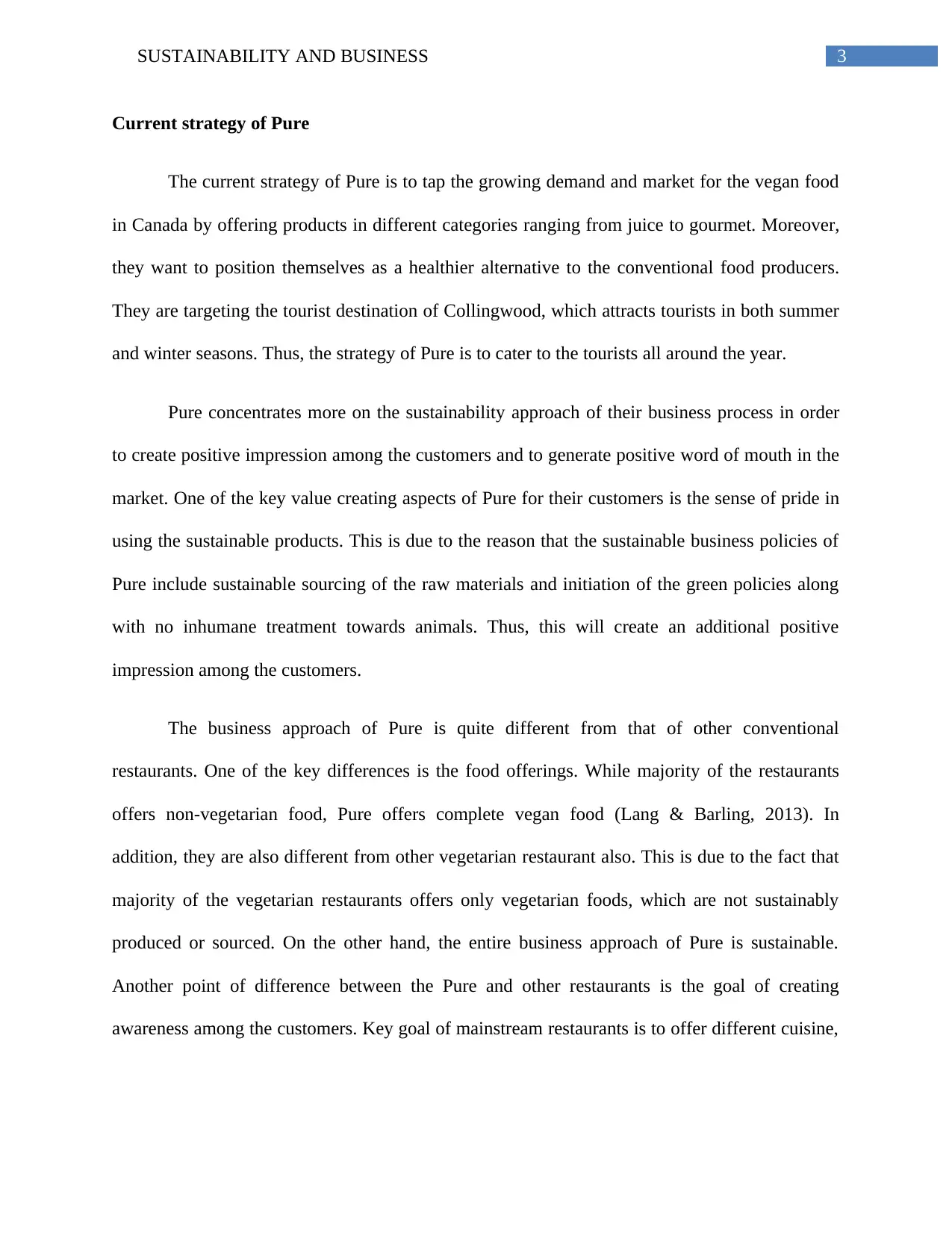
3SUSTAINABILITY AND BUSINESS
Current strategy of Pure
The current strategy of Pure is to tap the growing demand and market for the vegan food
in Canada by offering products in different categories ranging from juice to gourmet. Moreover,
they want to position themselves as a healthier alternative to the conventional food producers.
They are targeting the tourist destination of Collingwood, which attracts tourists in both summer
and winter seasons. Thus, the strategy of Pure is to cater to the tourists all around the year.
Pure concentrates more on the sustainability approach of their business process in order
to create positive impression among the customers and to generate positive word of mouth in the
market. One of the key value creating aspects of Pure for their customers is the sense of pride in
using the sustainable products. This is due to the reason that the sustainable business policies of
Pure include sustainable sourcing of the raw materials and initiation of the green policies along
with no inhumane treatment towards animals. Thus, this will create an additional positive
impression among the customers.
The business approach of Pure is quite different from that of other conventional
restaurants. One of the key differences is the food offerings. While majority of the restaurants
offers non-vegetarian food, Pure offers complete vegan food (Lang & Barling, 2013). In
addition, they are also different from other vegetarian restaurant also. This is due to the fact that
majority of the vegetarian restaurants offers only vegetarian foods, which are not sustainably
produced or sourced. On the other hand, the entire business approach of Pure is sustainable.
Another point of difference between the Pure and other restaurants is the goal of creating
awareness among the customers. Key goal of mainstream restaurants is to offer different cuisine,
Current strategy of Pure
The current strategy of Pure is to tap the growing demand and market for the vegan food
in Canada by offering products in different categories ranging from juice to gourmet. Moreover,
they want to position themselves as a healthier alternative to the conventional food producers.
They are targeting the tourist destination of Collingwood, which attracts tourists in both summer
and winter seasons. Thus, the strategy of Pure is to cater to the tourists all around the year.
Pure concentrates more on the sustainability approach of their business process in order
to create positive impression among the customers and to generate positive word of mouth in the
market. One of the key value creating aspects of Pure for their customers is the sense of pride in
using the sustainable products. This is due to the reason that the sustainable business policies of
Pure include sustainable sourcing of the raw materials and initiation of the green policies along
with no inhumane treatment towards animals. Thus, this will create an additional positive
impression among the customers.
The business approach of Pure is quite different from that of other conventional
restaurants. One of the key differences is the food offerings. While majority of the restaurants
offers non-vegetarian food, Pure offers complete vegan food (Lang & Barling, 2013). In
addition, they are also different from other vegetarian restaurant also. This is due to the fact that
majority of the vegetarian restaurants offers only vegetarian foods, which are not sustainably
produced or sourced. On the other hand, the entire business approach of Pure is sustainable.
Another point of difference between the Pure and other restaurants is the goal of creating
awareness among the customers. Key goal of mainstream restaurants is to offer different cuisine,
Paraphrase This Document
Need a fresh take? Get an instant paraphrase of this document with our AI Paraphraser

4SUSTAINABILITY AND BUSINESS
while the key objective of Pure is to aware the customers as well regarding the benefits of the
vegan and raw foods. Thus, they also offer tools for educating the customers.
Available alternatives
There are various alternatives available for Pure. However, the strategic alternatives
should be chosen based on their effectiveness in increasing the market share and customer reach.
One of the most effective strategic alternatives is the market development. This strategy refers to
the identification and entering in new markets in order to reach out to more number of customers
(Azaria et al., 2015). Thus, in the case of Pure, they can tap the market outside of Canada, where
popularity of vegan foods is growing. For instance, Pure can tap the market of the United States.
This will be beneficial for them due to the reason that the social culture between Canada and
United States is similar and Pure can take the same approach in doing business in the United
States. It will enable Pure to have the market of both the Canada and the United States.
Another available strategy is the diversification. This strategy refers to the initiation of a
completely new business line by Pure, which is not similar to their existing business. Pure can
introduce products in different business line but maintaining the same business approach of
sustainability (Chen et al., 2014). Thus, it will help them to cover diverse set of customers, which
will further enhance the market reach and brand image in the market. In addition, it will also help
them to reduce the business risk from the single business line.
Evaluation of the alternatives
Evaluating process should involve key performance indicators (Bai & Sarkis, 2014). This
will help Graham and Buob in setting the standards and benchmarks against which, the
alternatives will be evaluated. One of the key performance indicators will be the number of
while the key objective of Pure is to aware the customers as well regarding the benefits of the
vegan and raw foods. Thus, they also offer tools for educating the customers.
Available alternatives
There are various alternatives available for Pure. However, the strategic alternatives
should be chosen based on their effectiveness in increasing the market share and customer reach.
One of the most effective strategic alternatives is the market development. This strategy refers to
the identification and entering in new markets in order to reach out to more number of customers
(Azaria et al., 2015). Thus, in the case of Pure, they can tap the market outside of Canada, where
popularity of vegan foods is growing. For instance, Pure can tap the market of the United States.
This will be beneficial for them due to the reason that the social culture between Canada and
United States is similar and Pure can take the same approach in doing business in the United
States. It will enable Pure to have the market of both the Canada and the United States.
Another available strategy is the diversification. This strategy refers to the initiation of a
completely new business line by Pure, which is not similar to their existing business. Pure can
introduce products in different business line but maintaining the same business approach of
sustainability (Chen et al., 2014). Thus, it will help them to cover diverse set of customers, which
will further enhance the market reach and brand image in the market. In addition, it will also help
them to reduce the business risk from the single business line.
Evaluation of the alternatives
Evaluating process should involve key performance indicators (Bai & Sarkis, 2014). This
will help Graham and Buob in setting the standards and benchmarks against which, the
alternatives will be evaluated. One of the key performance indicators will be the number of
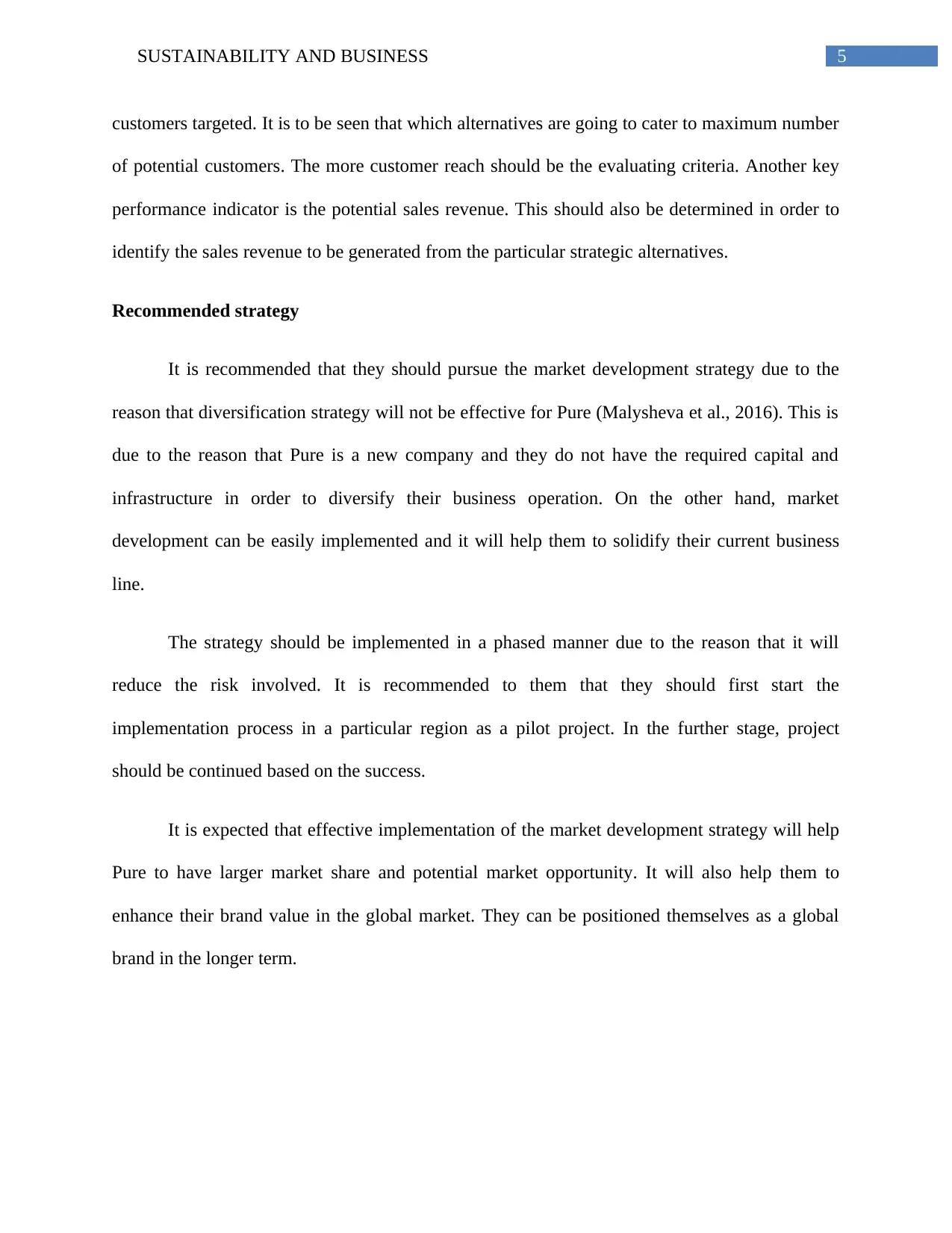
5SUSTAINABILITY AND BUSINESS
customers targeted. It is to be seen that which alternatives are going to cater to maximum number
of potential customers. The more customer reach should be the evaluating criteria. Another key
performance indicator is the potential sales revenue. This should also be determined in order to
identify the sales revenue to be generated from the particular strategic alternatives.
Recommended strategy
It is recommended that they should pursue the market development strategy due to the
reason that diversification strategy will not be effective for Pure (Malysheva et al., 2016). This is
due to the reason that Pure is a new company and they do not have the required capital and
infrastructure in order to diversify their business operation. On the other hand, market
development can be easily implemented and it will help them to solidify their current business
line.
The strategy should be implemented in a phased manner due to the reason that it will
reduce the risk involved. It is recommended to them that they should first start the
implementation process in a particular region as a pilot project. In the further stage, project
should be continued based on the success.
It is expected that effective implementation of the market development strategy will help
Pure to have larger market share and potential market opportunity. It will also help them to
enhance their brand value in the global market. They can be positioned themselves as a global
brand in the longer term.
customers targeted. It is to be seen that which alternatives are going to cater to maximum number
of potential customers. The more customer reach should be the evaluating criteria. Another key
performance indicator is the potential sales revenue. This should also be determined in order to
identify the sales revenue to be generated from the particular strategic alternatives.
Recommended strategy
It is recommended that they should pursue the market development strategy due to the
reason that diversification strategy will not be effective for Pure (Malysheva et al., 2016). This is
due to the reason that Pure is a new company and they do not have the required capital and
infrastructure in order to diversify their business operation. On the other hand, market
development can be easily implemented and it will help them to solidify their current business
line.
The strategy should be implemented in a phased manner due to the reason that it will
reduce the risk involved. It is recommended to them that they should first start the
implementation process in a particular region as a pilot project. In the further stage, project
should be continued based on the success.
It is expected that effective implementation of the market development strategy will help
Pure to have larger market share and potential market opportunity. It will also help them to
enhance their brand value in the global market. They can be positioned themselves as a global
brand in the longer term.
⊘ This is a preview!⊘
Do you want full access?
Subscribe today to unlock all pages.

Trusted by 1+ million students worldwide
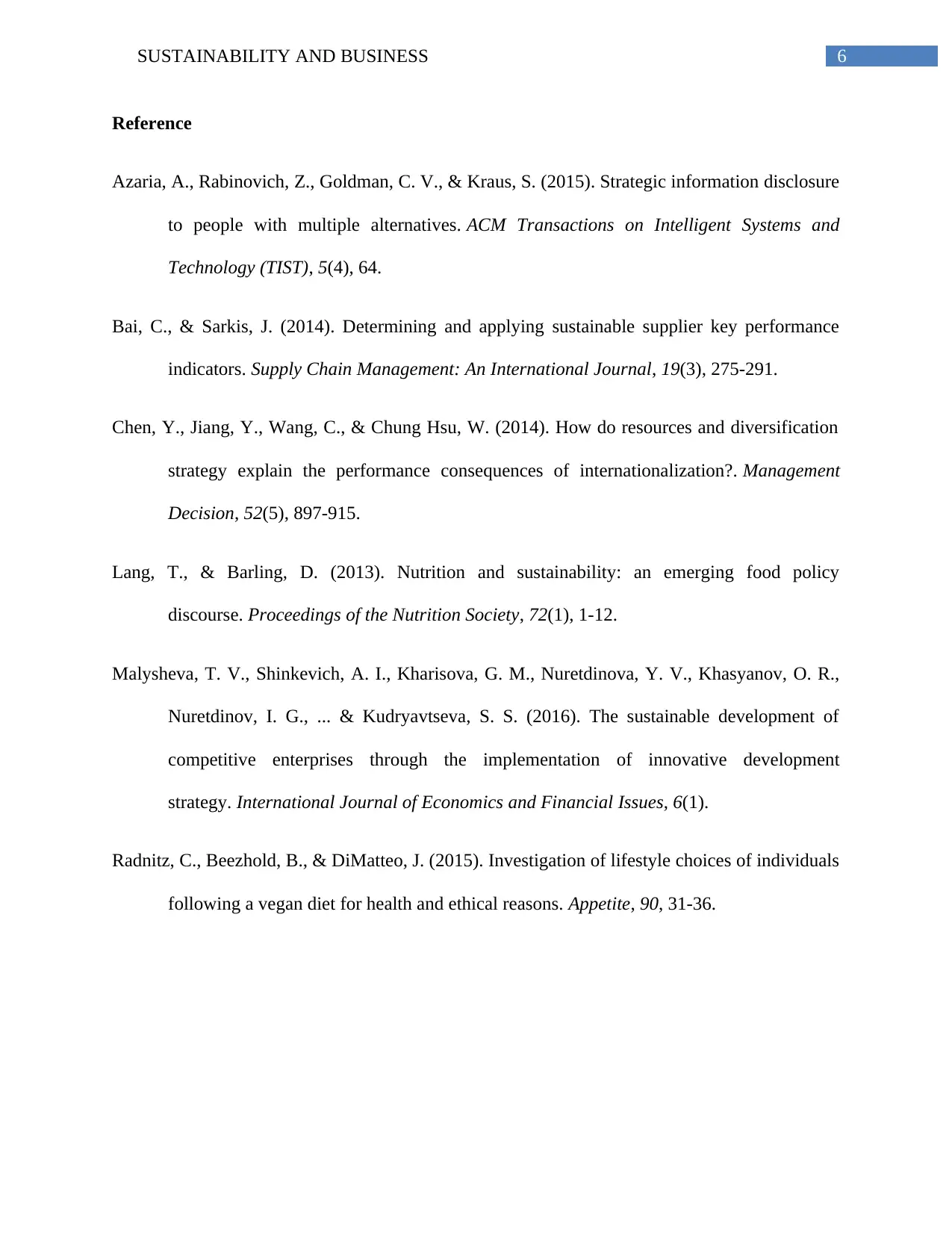
6SUSTAINABILITY AND BUSINESS
Reference
Azaria, A., Rabinovich, Z., Goldman, C. V., & Kraus, S. (2015). Strategic information disclosure
to people with multiple alternatives. ACM Transactions on Intelligent Systems and
Technology (TIST), 5(4), 64.
Bai, C., & Sarkis, J. (2014). Determining and applying sustainable supplier key performance
indicators. Supply Chain Management: An International Journal, 19(3), 275-291.
Chen, Y., Jiang, Y., Wang, C., & Chung Hsu, W. (2014). How do resources and diversification
strategy explain the performance consequences of internationalization?. Management
Decision, 52(5), 897-915.
Lang, T., & Barling, D. (2013). Nutrition and sustainability: an emerging food policy
discourse. Proceedings of the Nutrition Society, 72(1), 1-12.
Malysheva, T. V., Shinkevich, A. I., Kharisova, G. M., Nuretdinova, Y. V., Khasyanov, O. R.,
Nuretdinov, I. G., ... & Kudryavtseva, S. S. (2016). The sustainable development of
competitive enterprises through the implementation of innovative development
strategy. International Journal of Economics and Financial Issues, 6(1).
Radnitz, C., Beezhold, B., & DiMatteo, J. (2015). Investigation of lifestyle choices of individuals
following a vegan diet for health and ethical reasons. Appetite, 90, 31-36.
Reference
Azaria, A., Rabinovich, Z., Goldman, C. V., & Kraus, S. (2015). Strategic information disclosure
to people with multiple alternatives. ACM Transactions on Intelligent Systems and
Technology (TIST), 5(4), 64.
Bai, C., & Sarkis, J. (2014). Determining and applying sustainable supplier key performance
indicators. Supply Chain Management: An International Journal, 19(3), 275-291.
Chen, Y., Jiang, Y., Wang, C., & Chung Hsu, W. (2014). How do resources and diversification
strategy explain the performance consequences of internationalization?. Management
Decision, 52(5), 897-915.
Lang, T., & Barling, D. (2013). Nutrition and sustainability: an emerging food policy
discourse. Proceedings of the Nutrition Society, 72(1), 1-12.
Malysheva, T. V., Shinkevich, A. I., Kharisova, G. M., Nuretdinova, Y. V., Khasyanov, O. R.,
Nuretdinov, I. G., ... & Kudryavtseva, S. S. (2016). The sustainable development of
competitive enterprises through the implementation of innovative development
strategy. International Journal of Economics and Financial Issues, 6(1).
Radnitz, C., Beezhold, B., & DiMatteo, J. (2015). Investigation of lifestyle choices of individuals
following a vegan diet for health and ethical reasons. Appetite, 90, 31-36.
1 out of 7
Related Documents
Your All-in-One AI-Powered Toolkit for Academic Success.
+13062052269
info@desklib.com
Available 24*7 on WhatsApp / Email
![[object Object]](/_next/static/media/star-bottom.7253800d.svg)
Unlock your academic potential
Copyright © 2020–2025 A2Z Services. All Rights Reserved. Developed and managed by ZUCOL.




